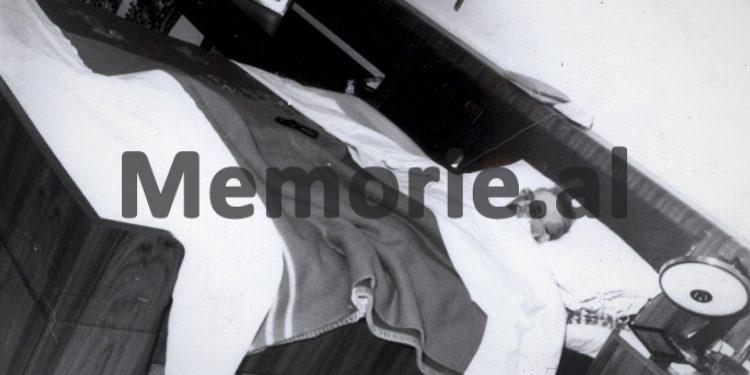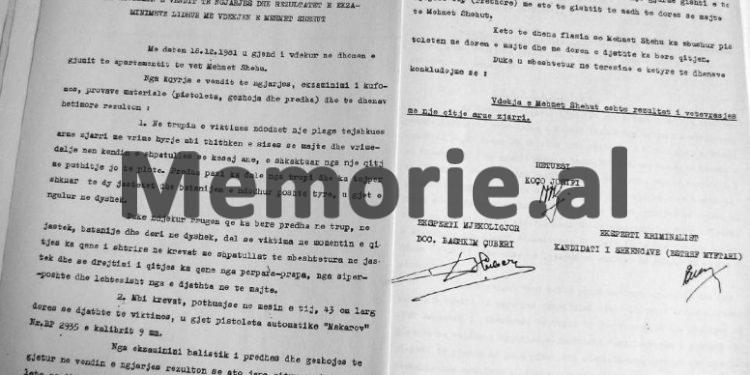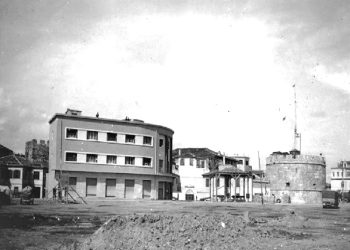By Dashnor Kaloçi
Part One
Memorie.al / 43 years ago, on the morning of December 18, 1981, the Albanian Prime Minister Mehmet Shehu, who had held that position since 1953, was found dead in his bedroom (according to the official version, from a bullet from a “pistol”), in the villa where he lived with his family, at the entrance to the “Block” of the high leadership of the Albanian Party of Labor, just a few meters from the building of the Central Committee of the Party and also from Enver Hoxha’s villa. Although more than four decades have passed since that day, considered one of the most serious and scandalous events of that regime, even today there is no clear and accurate version of what happened to the former Prime Minister of Albania, Mehmet Shehu, on the midnight transitioning to December 18, 1981! However, even after the 1990s, dozens of testimonies and archival documents have been made public concerning that event; “the murder or suicide of Mehmet Shehu” continues to be a subject of much debate and discussion, perhaps wrapping the truth surrounding it in even more mystery!
Given this fact, within the framework of publishing dozens of testimonies and archival documents from the secret fund of the former State Security and the Ministry of Internal Affairs, or from the Central Committee of the Party, which have been published in the three decades since the collapse of Enver Hoxha’s communist regime and that of his successor, Ramiz Alia, Memorie.al has secured the voluminous file of “the enemy Mehmet Shehu,” which has been extracted from the secret fund of the former State Security (at the Ministry of Internal Affairs), where, with a few small exceptions, the majority of them have never seen the light of publication and are being published for the first time.
In the mentioned file, the complete expert report of the investigative-operational group, which was established immediately on the morning of December 18, 1981, is found with its members, including Koço Josifi (head of the Investigation of the Directorate of Internal Affairs of Tirana), forensic doctors Dr. Fatos Harito and Docent Bashkim Çuberi, the doctors of the Prime Minister, Milto Kostaqi and Llesh Rroku, as well as the criminal expert from the Central Criminalistics Laboratory of the Ministry of Internal Affairs, Estref Myftari.
Also in the mentioned file are the testimonies of the family members of former Prime Minister Mehmet Shehu, service personnel, and his escort group, as well as all the other individuals who were called and testified regarding that event. More about this, etc., is informed by the documents in question, which we are publishing together with their facsimiles and respective photos.
ARCHIVAL DOCUMENT WITH THE FINDINGS OF THE STUDY OF THE CRIME SCENE AND EXAMINATIONS REGARDING THE DEATH OF MEHMET SHEHU, BY THE HEAD OF THE INVESTIGATION KOÇO JOSIFI, FORENSIC DOCTOR BASHKIM ÇUBERI, AND CRIMINAL EXPERT ESTREF MYFTARI
C O N C L U S I O N S
ON THE STUDY OF THE CRIME SCENE AND THE RESULTS OF THE EXAMINATIONS REGARDING THE DEATH OF MEHMET SHEHU
On December 18, 1981, Mehmet Shehu was found dead in his bedroom.
From the examination of the crime scene, the autopsy, material evidence (pistol, cartridge, and bullet), and investigative data, it is concluded:
On the body of the victim, there is a penetrating wound from a firearm, with an entry hole above the left nipple and an exit hole beneath the shoulder on that side, caused by a shot with an incomplete trigger pull. The bullet, after exiting the body and passing through both pillows and the blanket underneath them, was found lodged in the mattress. Following the path that the bullet traveled through the body, into the pillow, blanket, and down to the mattress, it appears that the victim, at the moment of the shot, was lying in bed, with his shoulders supported on the pillow, and that the direction of the shot was from front to back, from above downward, and slightly from right to left.
On the bed, almost in its middle, 43 cm away from the victim’s right hand, the automatic pistol “Makarov” No. BP 2935, of 9 mm caliber, was found. From the ballistic examination of the bullet and cartridge found at the crime scene, it is concluded that they were fired from this pistol, which was owned by Mehmet Shehu himself.
The right hand of the victim was in a state of rigor mortis, with the index finger more flexed than the others, while on the nail of the thumb of this hand and on the skin 2-3 mm away from it, traces of gunpowder residue were found. On the right side of the pistol’s trigger guard, a fingerprint identical (circular) to that of the thumb of Mehmet Shehu’s left hand was discovered. These data indicate that Mehmet Shehu loaded the pistol in his left hand and, with his right hand, fired the shot.
Based on the entirety of this evidence, we conclude that:
The death of Mehmet Shehu is the result of suicide by a firearm shot.
INVESTIGATOR
KOÇO JOSIFI
FORENSIC DOCTOR CRIMINAL EXPERT
BASHKIM ÇUBERI CANDIDATE OF SCIENCES (ESTREF MYFTARI)
ARCHIVAL DOCUMENT WITH THE DECISION TO TERMINATE THE CRIMINAL CASE FOR MEHMET SHEHU’S SUICIDE, SIGNED BY THE INVESTIGATOR OF THE TIRANA DIRECTORATE OF INTERNAL AFFAIRS, KOÇO JOSIFI
DECISION
ON THE TERMINATION OF THE CRIMINAL CASE
Tirana, December 29, 1981
I, Koço Josifi, investigator of the Directorate of Internal Affairs of Tirana, after reviewing the materials of criminal case No. 794 regarding the suicide of Mehmet Shehu;
FINDINGS
On December 13, 1981, we initiated the criminal case regarding the suicide of Mehmet Shehu. From the investigations conducted, it was found that on December 18, 1981, at around 8:00 AM, Mehmet Shehu was found dead in his bedroom.
At this hour, Fiqiret Shehu entered his room, discovering that he had died; she immediately informed her son, Vladimir Shehu, who, along with his wife, Fatbardha Shehu, and Fiqret Shehu, went to the room where they confirmed his death.
Vladimir Shehu immediately notified the duty officer and the doctors, witnesses Ali Çeno, Milto Kostaqi, and Llesh Rroku, who found him lying dead in bed.
After this, the investigative-operational group arrived at the scene, and from the examination of the crime scene and the forensic examination of the body, the ballistic examination of the RP 29-35 type pistol, the bullet and cartridge found at the crime scene, fingerprint analysis from the pistol, investigative experiments and witness testimonies, it is fully verified that:
The enemy Mehmet Shehu, at the dawn of December 18, 1981, used his personal pistol, a RP. 29-35, 9 mm caliber, to commit suicide with a single shot, with an incomplete trigger pull, with an entry wound to the left front of the chest and an exit wound to the left side of the back. The death was caused by this tragic incident.
The suicide is confirmed to have occurred under these circumstances:
The enemy Mehmet Shehu, at the moment of the suicide, was lying in bed, with his shoulders supported on the pillow. The shot was fired with the direction from front to back, from above downward, and slightly from right to left.
From the ballistic examination of the bullet and cartridge found at the crime scene, it is confirmed that they were fired from the RP 29-35 pistol possessed by Mehmet Shehu himself.
The index finger of the right hand, found in a more flexed position than the others during the examination, had traces of gunpowder residue on the nail of the thumb of this hand and on the skin 2-3 mm away from it. In addition, on the right side of the pistol’s trigger guard, a fingerprint of the same type (circular) as that of the thumb of Mehmet Shehu’s left hand was discovered. This evidence indicates that he loaded the pistol in his left hand and, using his right hand, fired the shot and committed suicide.
Based on the above findings and in accordance with Article 71 of the Penal Procedure Code of the People’s Republic of Albania;
IT IS DECIDED:
To terminate the criminal case for the investigation of the suicide of enemy Mehmet Shehu, since it does not contain the elements of a criminal act.
THE INVESTIGATOR
KOÇO JOSIFI
ARCHIVAL DOCUMENT WITH THE DECISION TO INITIATE THE CRIMINAL CASE FOR THE SUICIDE OF MEHMET SHEHU, BY THE CHAIRMAN OF THE INVESTIGATION BRANCH OF THE TIRANA DIRECTORATE OF INTERNAL AFFAIRS, KOÇO JOSIFI
DECISION
ON THE INITIATION OF THE CRIMINAL CASE
Tirana, December 18, 1981
I, Koço Josifi, chairman of the Investigation Branch of the Directorate of Internal Affairs of Tirana, after studying the materials related to the suicide of citizen Mehmet Ismail Shehu:
FINDINGS:
Based on the report made, on December 18, 1981, at 8:00 AM, citizen Mehmet Ismail Shehu was found dead in his bedroom.
Considering that the above material serves for the initiation of the criminal case, based on Article 63 of the Penal Procedure Code of the People’s Republic of Albania;
IT IS DECIDED:
Based on the materials mentioned above, to begin the criminal case for the crime stipulated in Article 89 of the Penal Code.
A copy of this decision shall be sent to the Prosecution.
CHAIRMAN OF THE INVESTIGATION BRANCH
KOÇO JOSIFI
ARCHIVAL DOCUMENT WITH THE PROTOCOL FOR SUPERVISION OF THE CRIME SCENE REGARDING THE DEATH OF MEHMET SHEHU, BY INVESTIGATOR KOÇO JOSIFI, CRIMINAL EXPERT ESTREF MYFTARI, FORENSIC EXPERTS DOC. BASHKIM ÇUBERI AND DR. FATOS HARITO, AND PRESENT WITNESSES, ALI ÇENO AND MILTO KOSTAQI
PROTOCOL
FOR THE SUPERVISION OF THE CRIME SCENE
Tirana, December 18, 1981
I, Koço Josifi, chairman of the Investigation Branch of the Directorate of Internal Affairs of Tirana, according to the notification, formed the investigative team, consisting of myself, criminal expert Istref Myftari, forensic expert Doc. Bashkim Çuberi, assisted by witnesses Ali Çeno and Milto Kostaqi, conducted the inspection of the crime scene regarding the death of Mehmet Shehu.
The apartment is located in Block No. 8, a two-story building, on the second floor. After climbing the stairs, on their left side, there is a corridor. Behind it, there is a small foyer, which contains a sofa and a small wooden table. From here, you enter the bedroom of Mehmet Shehu’s apartment, where a window, closed with shutters and nylon curtains, is located directly opposite the entrance door to the room.
The room measures 6 m x 6 m, with a height of 2.90 m. On the southern side, there is a double door that communicates with a veranda, which was found closed with shutters and thick curtains. The door leading to the bathroom was found half open, with the key inserted in the lock. On the northern side, there is a door that leads to the veranda, and another door that communicates with his office, both of which were found to be properly closed.
The room is carpeted and furnished with a bedroom set, which has a dressing mirror on the western wall, a wardrobe, and on the northern side, a small side table and a sofa. In the room, there is also a medical exercise bike and a scale.
The bed is made of walnut-colored furniture, with the headboard structured like furniture, measuring 181 cm wide. On the left side, there is an extension of 78 cm, and on the right side, an extension of 138 cm, with a height of 90 cm. The left arm section is in the form of a nightstand, with a drawer and a compartment underneath. On this section of the nightstand, which measures 22 cm wide, there is a “SANYO” transistor.
On the nightstand, there is a lit lamp, a signaling button holder, a flashlight, an intercom, a book titled: “For Voluntary Afghan Camp SN.10”, a thermos, a teacup with a little yellow liquid with a chamomile scent, a glass of water half-filled with a clear liquid, and a transparent plastic box, on the lid of which is written:
“Before sleeping,” inside it appears to hold an orange capsule, half a blue tablet, and two very small light pink tablets, a 2000 cubic cm bottle filled two-thirds full with a thick liquid labeled “Agerol”, a black metal key holder with 11 keys of various kinds, and a 9 mm pistol cartridge, numbered 81-66, which smells faintly of gunpowder.
The cartridge is taken as material evidence. On the lower part of this nightstand, there is a telephone and three books with the titles: “Discovering the World”, in a foreign language: “Les grandes patries étranges”, “Le erogzoletaipin mbgreme”, “Arehrepel du tiki”, “La valleo des”, “Rois”, “Calendario atlaste de agostin 1979”, “Celtes et l’expansion celtique”, “La bete el lepaporo”, “Cap a l’coneit”, “Alor e de la forot vrerge”, “Srudi taim çudio”, “Ndren de la liberte”, “Amaniak”, “Drame erotiqueo”.
Inside the drawer of this nightstand, various medications were found, such as: Papaverine, Clorartin, Adalat, Imatotol (three bottles), Rokuol Valium, Drabinil-Rieka, Kodotusil, Karvosin (two bottles), Ritaolol, Codeine, Posilie Valur (half a box), two boxes of Nivea cream, three tablets of Culzalon, a thermometer, a small leather bag containing these medications: Kalreton (three tablets), Avlokalidm, Umenditol, Punetaral, Magzoform, Kapoform, Trinitrin, and a Tarnomatsi and Codeine.
On the right arm of the bed extension, there were two framed photos of children, and a signaling button box was found. Below were: a “Kematofon” tape recorder, brand “Nacional – përladonin”, a “Grundig” transistor radio, a suitcase with a pencil inside.
In the left arm drawer, there were three pairs of optical glasses, as well as another pair of optical glasses, a small “Sango” tape recorder, a plate with three chocolates, five small batteries, a box of “Selty” supports, and a box of “Anoide” supports. In the middle drawer, various newspapers and some translated letters, as well as some small packages, which on our part, were not opened. In the third drawer, various photographs, cardboard, and two packages which were not opened were found.
On the left side of the bed, there are three corpses (deceased individuals), of a male approximately 70 years old, lying on his back, with his head slightly elevated, placed on two pillows and a folded blanket under them. Both arms are bent at the elbows, resting on the body, with fingers partially curled, and the legs are stretched horizontally, covered with a blanket and the sheet of the bed, up to near the chin.
Almost in the middle of the bed, on the upper blanket, 48 cm away from the right hand, and to the right of the corpse, there is a “Makarov” pistol, number RP 29-35, manufactured in 1954. The pistol was found loaded with one bullet in the chamber and five others in the magazine. The pistol, along with the bullets, was taken by us as material evidence. /Memorie.al



















